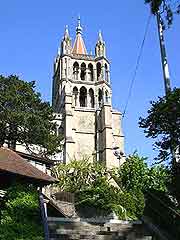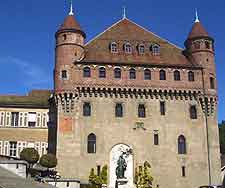Lausanne History Facts and Timeline
(Lausanne, Vaud, Switzerland)

An appealing historic city with both Celtic and Roman origins, Lausanne boasts an interesting history. It is known that the region around the Vidy area even once supported a Neolithic community.
The Roman army arrived here at the very beginning of the first century and built their military camp alongside Lake Geneva (Lake Léman), close to the site of the present-day Ouchy port and nearby the 'Lausodunon' hill fortress. They named their settlement 'Lousonna' and this site remains today, close by, serving as an ancient archaeological site, where elements of its former Roman occupation are clearly visible. These include the remains of a forum, temple and port, as well as a sizeable church (basilique).
The End of the Roman Empire
The settlement soon became known as Lousonnensium, later changing its name once more to Lausonio towards the end of the 3rd century. By the beginning of the 5th century, the name had changed yet again, this time to Lausanna. The once proud empire of the Romans soon started to collapse, for various reasons, and a new era in Lausanne history was about to begin.
The settlement was relocated to a more strategic elevated setting close by, which overlooked the lake and would prove far easier to defend. This is now the site of today's Old Town. Various rulers emerged over the centuries to follow, including the House of Savoy and then the Prince-Bishop of Lausanne (of the Holy Roman Empire). The Cathedral of Notre Dame was completed in 1240, after no less than seven decades' worth of construction, and its beautiful Gothic-style architecture can still be admired today.

Troubles Around the Corner
By the 13th century, almost 10,000 people lived here, making Lausanne one of the biggest and most important of all the Swiss cities. However, major set backs in the history of Lausanne soon came in the form of terrible fires - destroying many of the predominantly wooden buildings, as well as plague epidemics and spells of infighting.
Berne gained much power in the 1530s and soon it was to rule over Lausanne for several centuries, right up until 1798. The city's importance and status declined under the Berne regime, although the founding of the University of Lausanne (UNIL) in 1537 certainly marked a highpoint.
In the year of 1803, Napoleon Bonaparte was rapidly rising through the ranks of the French army and following his 'Act of Mediation', the Swiss Confederation was resurrected. At this stage, Lausanne was awarded the prestigious title of Vaudois capital. Bridges were built, suburbs appeared and a social unity prevailed.
A More Modern Period of History
The hosting of the hugely successful Swiss National Exhibition helped to put Lausanne well and truly on the tourist map of Europe. Visitors searching out history in the city need only stroll around the cobbled streets of the surprisingly large Old Town (Vieille Ville) to gain a real feeling of the past.
The cathedral (Cathédrale de Notre Dame) on the Place de la Cathédrale presides over the Old Town, overlooking its plentiful gift shops, pavement cafes and tempting restaurants. For some unmissable views, consider climbing to the very top of the cathedral tower (between 10:00 and 14:00).
 An appealing historic city with both Celtic and Roman origins, Lausanne boasts an interesting history. It is known that the region around the Vidy area even once supported a Neolithic community.
An appealing historic city with both Celtic and Roman origins, Lausanne boasts an interesting history. It is known that the region around the Vidy area even once supported a Neolithic community.